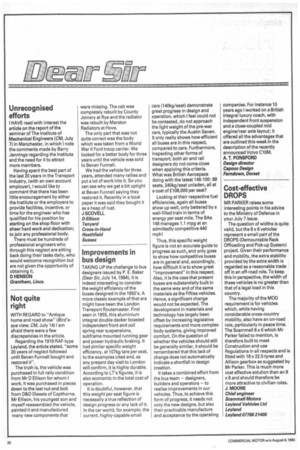Improvements in bus design
Page 22

If you've noticed an error in this article please click here to report it so we can fix it.
TAKING UP the challenge to bus designers issued by P. E. Baker (Dear Sir, July 14, 1984), it is indeed interesting to consider the weight efficiency of the buses designed in the 1950's. A more classic example of that era might have been the London Transport Routemaster. First seen in 1955, this aluminium integral double decker boasted independent front and coil spring rear suspensions, subframe mounted running gear and power hydraulic braking. It had similar specific weight efficiency, at 107kg tare per seat, to the examples cited and, as any present day visit to London will confirm, it is highly durable. According to LT's figures, it is also economic in the total cost of operation.
It is doubtful, however, that this weight per seat figure is necessaily a true reflection of design progress or any lack of it. In the car world, for example, the current, highly-capable small cars (140kg/seat) demonstrate great progress in design and operation, which I feel could not be contested, do not approach the light weight of the pre-war cars, typically the Austin Seven. It only really shows how efficient all buses are in this respect, compared to cars. Furthermore, inspecting other forms of transport, both air and rail designers do not come close when applying this criteria. What was British Aerospace doing with the latest 146-100: 88 seats, 240kg/seat unladen, all at a cost of £108,000 per seat?
Looking at their respective fuel efficiencies, again all buses show up well, only bettered by a well-filled train in terms of energy per seat mile. The BAe 146 manages 1.1 mpg at an admittedly competitive 440 mph!
Thus, this specific weight figure is not an accurate guide to progress as such and only goes to show how competitive buses are in general and, accordingly, how difficult it is to show great "improvement" in this respect. Also, it is the case that present buses are substantially built in the same way and of the same materials as the Fifties vehicles. Hence, a significant change would not be expected. The development in materials and technology has largely been offset by increasing legislative requirements and more complex body systems, giving improved comfort. On the question of whether the vehicles should still be generally similar, it should be remembered that this lack of change does not automatically indicate a shortfall in design creation.
It takes a combined effort from the bus team — designers, builders and operatora — to realise improvements in our vehicles. Thus, to achieve this form of progress, it needs not only the new designs, but also their practicable manufacture and acceptance by the operating companies. For instance 10 years ago I worked on a British integral luxury coach, with independent front suspension and a close-coupled mid engine/rear axle layout; it offered all the advantages that are outlined this week in the description of the recently announced Volvo C10M. A. T. PONSFORD Design director Capoco Design Femdown, Dorset
























































































